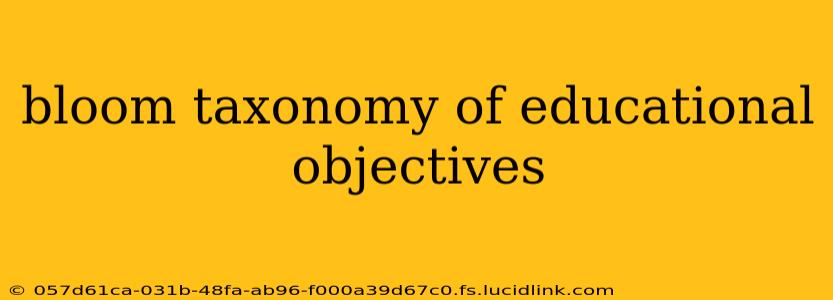Bloom's Taxonomy of Educational Objectives: A Comprehensive Guide
Bloom's Taxonomy is a hierarchical model that classifies educational learning objectives into six cognitive levels. Understanding this framework is crucial for educators, curriculum designers, and anyone involved in creating effective learning experiences. This guide will delve into each level, providing examples and clarifying its practical application.
What is Bloom's Taxonomy?
Developed by Benjamin Bloom in 1956, Bloom's Taxonomy provides a common language for educators to define and communicate learning goals. It moves from simpler cognitive processes to more complex ones, building a foundation for progressively higher-order thinking. While the original taxonomy has been revised (more on that later), the core principle remains the same: to structure learning objectives for better assessment and instruction.
The Revised Bloom's Taxonomy (2001):
The original taxonomy used nouns (Knowledge, Comprehension, Application, Analysis, Synthesis, Evaluation) to describe the cognitive levels. The revised version, spearheaded by Anderson and Krathwohl, uses verbs, making the levels more action-oriented and easier to understand. This revision also shifted the highest level from "Evaluation" to "Creating."
Here's a breakdown of the six levels in the revised Bloom's Taxonomy:
1. Remembering (Knowledge):
This is the foundational level, focusing on recalling facts, terms, concepts, and procedures. It's about retrieving information from long-term memory.
- Keywords: Define, list, name, identify, recall, recognize, state.
- Example: List the planets in our solar system.
2. Understanding (Comprehension):
This level involves demonstrating comprehension of the meaning of learned material. Students should be able to explain ideas, interpret information, and summarize concepts.
- Keywords: Explain, summarize, paraphrase, interpret, describe, classify, discuss.
- Example: Explain the concept of photosynthesis.
3. Applying (Application):
At this level, students use learned information in new situations. They apply knowledge and skills to solve problems or complete tasks.
- Keywords: Apply, use, solve, demonstrate, illustrate, calculate, implement.
- Example: Use the Pythagorean theorem to calculate the length of the hypotenuse.
4. Analyzing (Analysis):
Analysis involves breaking down information into its constituent parts and examining the relationships between them. Students identify patterns, make inferences, and draw conclusions.
- Keywords: Analyze, compare, contrast, differentiate, distinguish, examine, investigate.
- Example: Analyze the causes of the American Civil War.
5. Evaluating (Evaluation):
This level involves making judgments based on criteria and standards. Students assess the value, worth, or quality of information, ideas, or methods.
- Keywords: Evaluate, judge, assess, critique, justify, support, compare and contrast.
- Example: Evaluate the effectiveness of different marketing strategies.
6. Creating (Synthesis):
This is the highest level, involving putting elements together to form a coherent whole, or creating something new and original.
- Keywords: Create, design, plan, produce, invent, compose, formulate, develop.
- Example: Develop a marketing plan for a new product.
Frequently Asked Questions (FAQs):
How is Bloom's Taxonomy used in curriculum design?
Bloom's Taxonomy guides curriculum development by ensuring that learning objectives are clearly defined and sequenced appropriately. It helps educators design lessons and assessments that challenge students at different cognitive levels, promoting deeper understanding and higher-order thinking.
What are some examples of assessment methods for each level of Bloom's Taxonomy?
- Remembering: Multiple-choice tests, fill-in-the-blank questions.
- Understanding: Short answer questions, paraphrasing exercises.
- Applying: Problem-solving tasks, case studies.
- Analyzing: Essay questions requiring comparison and contrast, identifying biases.
- Evaluating: Critiques, debates, design projects with evaluation criteria.
- Creating: Research projects, presentations, creative writing assignments.
How does Bloom's Taxonomy benefit students?
By progressing through the levels of Bloom's Taxonomy, students develop critical thinking, problem-solving, and creative skills. This leads to a deeper understanding of the subject matter and improved learning outcomes.
What are the limitations of Bloom's Taxonomy?
While valuable, Bloom's Taxonomy isn't without its limitations. Some argue that the levels are not always clearly defined, and the process of classifying learning objectives can be subjective. Furthermore, real-world learning often involves a blend of cognitive processes, not neatly categorized levels.
In conclusion, Bloom's Taxonomy remains a powerful tool for educators and instructional designers. By understanding and applying its principles, we can create more effective learning experiences that foster deeper understanding and higher-order thinking skills in students. While it has its limitations, its overall contribution to educational planning and assessment remains significant.
